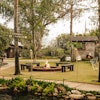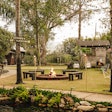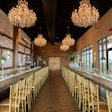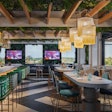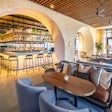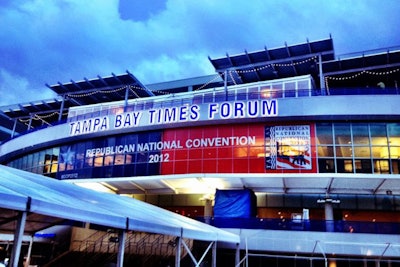
The Republican National Convention will be remembered as the convention that almost didn’t happen. In the days leading up to the event in Tampa, Hurricane Isaac was forecast on a track that threatened to bring dangerous wind and heavy rain to the coastal city. In the end, the storm veered farther west and only prompted organizers to cancel the first day of activities, Monday, August 27. But the uncertainty about the weather created headaches for planners and vendors who had spent months creating events and accommodations to welcome and entertain the 50,000 delegates, media, V.I.P.s, and visitors to town.
One company directly affected by the weather concerns was Karl’s Event Services, which had contracts to erect more than 128,000 feet of tenting and temporary structures around Tampa for clients such as Fox News, Bloomberg, Jamestown Entertainment, and the convention organizing committee. We spoke to Austin Walker, national accounts manager for Karl’s, about the work they did and the lessons they learned.
One of your biggest clients was the Committee on Arrangements for the Republican National Committee, which was the group that managed the convention. Tell us about that.
They wanted to make it so when any delegate got off the bus and had to walk from the metal detector tent all the way to the Tampa Bay Times Forum, they didn’t want them exposed not only to rain but sun and heat and the elements of Florida weather. We constructed and designed this complex of walkways that would lead from all the bus stops to the Forum. That ended up being about 3,250 linear feet, about three-quarters of a mile of temporary walkway. Nobody in the country had that sort of inventory of walkway. We put in a huge capital expenditure to purchase this inventory new for this event.
You built these tented walkways all around downtown Tampa, but then they were damaged about a week before the convention opened, and that had nothing to do with Hurricane Isaac.
The Monday before the convention, I got a call at about 11 o’clock at night and they say, "We think you need to come down to Tampa. We hear that all the tents in front of the convention center have been ripped to shreds and are in the street." I get there and a microburst [a tornado-like burst of air] has gone through downtown Tampa right at the forum and has ripped about 25 percent of the project to shreds. It had ripped the vinyl, it had mangled the metal. It was mind-boggling. All of these tents were weighted the way they should have been. It was a freak storm. I woke all of our crew up and stayed down there with them and we pretty much cleaned up as much as we could. By 7 a.m. we had the whole site cleaned, and we got it back in a position where whoever was coming in would only see a job site in progress. It didn’t look like anything happened.
By the time you got those tents fixed midweek, Hurricane Isaac was becoming a legitimate threat. What then?
We have a safety and compliance expert on staff. He flew into town, and we established what our policies would be for all of our clients. In our contracts we always state at what point the structure or tent should be evacuated and at what point the structure or tent, per the engineering documents, is most likely going to fail. It is a huge gap in between those because we always want to err on the side of safety. We had conference calls with every single one of our clients and emailed out spec sheets on how and when to evacuate the structures. We wanted to make sure every single client was very aware that this is your call, but this is what we are going to tell you should be done to keep everyone safe.
When did you make the decision to pull the tents?
Once we knew Tampa went under a tropical storm warning Saturday night, that’s when we made the call to take all the vinyl off of the walkway tents. Tents can fail sooner than structures. I went to Tampa with our executive team, and we decided to take it all off. The structures were still going to be intact because we were not expecting hurricane-force winds. We just secured them, put in extra straps and weights to hold them down.
The worst of the wind and rain was on Sunday, August 26, and early Monday, August 27, in Tampa. You had very little time to get the walkways back up before the convention opened, a day late, on Tuesday.
We put everything back up late Monday night into Tuesday morning. I met our crew in the middle of the night and we just went at it. We dispatched a caravan of seven trucks carrying materials and labor. We worked from midnight till 11 in the morning. We started with getting all the walkways back together from the forum out on the first night. Then Tuesday night we worked all through the night to get the rest of it done. By noon on Wednesday [August 29], we were all finished with the original scope of work.
What did you learn from this experience?
At the end of the day it was a good exercise for us to see how fast we can react to a storm like this. Part of our company is disaster-relief. We have a whole branch that specializes in immediate response. We have trucks of cots and shower trailers, bathroom trailers. We can build a base camp at the flip of a switch. But we don’t get to practice those skills on the corporate and social event side. So in that sense it was good for us as a team to learn from that.
As much as you sit at your desk and you wonder, "How upset is my client going to be when I say we have to take everything down when it might, potentially could, may be a storm?" It’s always better to err on the side of safety. All that anxiety that comes with breaking that news to your client—once the client hears that come out in your voice, they are relieved to hear you are caring and you are watching them and you have the ability to take it all down and put it all back up to make sure nobody gets hurt. I’d never been put in the position of having to make these emergency calls to a client, so that was a big lesson for me. It showed me your clients really do understand emergency situations, and they are just as willing to err on the side of safety and caution as you are as the vendor.



